Global warming threatens the world’s granaries. Human actions are accelerating climate change,leading to drastic changes in temperatures that should not be taking place. Causing significant crop productivity drops in certain parts of the world which are already experiencing the consequences of desertification.
On the other hand, scientists predict an increase in the potential productivity of many previously unused areas. This points to a significant shift in the map of global food production, which must be considered for any reasonable social, political, or economic plan.
With a global population projected to reach 9 billion in the next 30 years, the amount of food produced in the world will have to increase significantly or be distributed more effectively. It is worth noting that currently a large portion of the land being used to grow wheat, corn, and rice is vulnerable to the effects of global warming.
Alarming predictions
Scientists are using new approaches that combine standard climate change models with data on maximum land productivity to predict how potential crop yields are likely to change in the next 50-100 years as a result of climate change.
The results show that nearly half of all maize produced worldwide (43%) and one-third of all wheat and rice (33% and 37% respectively) are grown in areas that are vulnerable to the effects of climate change. Crop lands in tropical regions, including sub-Saharan Africa, South America, and the United States, are likely to experience the most drastic reductions regarding the projected productivity of these crops.
While the effects of climate change are expected to be more significant in the poorest regions of the world, scientists suggest that developed countries will also be affected, either directly or indirectly.
Significant effects
Efforts to increase food production generally focus on closing the yield gap, which means minimizing the difference between what could potentially be grown in a given area of land and what is actually harvested.
Highly developed countries already have a very small yield gap, so the negative effects of climate change on potential yields are likely to be felt more intensely in these areas.
According to the models, experts believe that the potential for improving yields in current high-production areas is largely reduced as a result of the effects of climate change.
However, they also believe that it presents an interesting opportunity for some countries in temperate regions, as climate suitability for growing staple foods is likely to increase in those areas over the same time period.
The political, social, and cultural effects of these major changes in the distribution of cultivated lands would be profound. Regions that are currently considered productive could be transformed and become net importers, and vice versa. While climate is one of the factors to consider in the future of agriculture, scientists warn that it should not be underestimated.
Final considerations
Factors such as soil quality and water availability, which are distinctly local, also have a significant effect on crop yields in practical terms. However, meeting the demand for the three major cereal crops in the world will require finding sustainable solutions. The future of the planet depends on it.
You may also like to read: “International soybean and wheat prices drop 5% and 12% in the last 15 days.”
Source: Taken and modified from press release in Spanish by ecoticias.com. Read original content here
